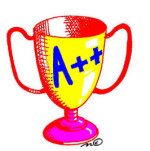BIO100 Biology Concepts Lesson 14 Quiz 11
- From Biology, General Biology

- Mastermind
- Rating : 6
- Grade : A+
- Questions : 0
- Solutions : 3687
- Blog : 0
- Earned : $13683.31

1 of 20
What name is given to the food-trapping cells of sponges?
Phagocytes
Amoebocytes
Cnidocytes
Choanocytes
2 of 20
All animals
are prokaryotic.
are heterotrophic.
have cell walls made of chitin.
obtain food by absorption.
3 of 20
Features unique to mammals include
the presence of hair.
extended parental care of the young.
being endotherms.
having no egg-laying members.
4 of 20
Which of the following levels of structure encompasses all the others?
Tissue
Cell
Organ
Organism
5 of 20
Which of the following animals does not have a body cavity?
Ant
Mouse
Flatworm
Clam
6 of 20
Sharks are a type of
Tunicate.
Cartilaginous fish.
Bony fish.
Lungfish.
7 of 20
The water vascular system of a sea star functions in
movement of the tube feet.
circulation of nutrients around the body.
pumping water for swimming movements.
buoyancy
8 of 20
Neurons are specialized cells characteristic of
muscle tissue.
connective tissue.
epithelial tissue.
nervous tissue.
9 of 20
A(n) ______ is an example of an invertebrate chordate.
snake
echinoderm
lancelet
fish
10 of 20
Animals probably evolved from protists. How do animals differ from these protist ancestors?
Animals are eukaryotic.
Animals have more specialized cells.
Animals are heterotrophic.
Animals are able to reproduce.
11 of 20
Homeostasis is
the exchange of materials with the surrounding environment.
the idea that all vertebrates are built in a similar way.
the correlation of structure and function.
maintaining a relatively constant internal environment.
12 of 20
Unique features of vertebrates include the presence of a(n)
skull and backbone
notochord
endoskeleton
pharyngeal slit
13 of 20
A marine biologist dredged up a small animal from the ocean floor. It was uniformly segmented, with short, stiff appendages and soft, flexible skin. It had a complete digestive system and a closed circulatory system but no skeleton. Based on the description, this animal sounds most like a(n)
lancelet.
crustacean.
annelid.
mollusk.
14 of 20
The feature present in reptiles and absent in amphibians that freed reptiles from the dependence on
water for reproduction is
parental care of eggs.
metamorphosis.
the lateral line system.
the amniotic egg.
15 of 20
A change in the body often triggers a response that counteracts the change. This kind of response is known as
negative feedback.
empowerment.
cause and effect.
positive feedback.
16 of 20
A _____ is a chordate, but not a vertebrate.
squid
tunicate
shark
frog
17 of 20
Pill bugs" or "sow bugs", often found under rocks and logs in moist places, have the ability to roll up into a ball when disturbed. Sow bugs are really crustaceans, not insects. Therefore, sow bugs do not have
an exoskeleton.
gills.
three pairs of legs.
antennae.
18 of 20
Which of the following tissues produces voluntary body movements?
Smooth muscle
Simple cuboidal epithelium
Cardiac muscle
Skeletal muscle
19 of 20
Which of the following are listed in the correct hierarchal order?
System-tissue-organ
Cell-tissue-organ
Organ-tissue-system
Tissue-cell-organ
20 of 20
Which of the following animals displays radial symmetry?
A worm
A sea anemone
A fish
A lobster
[Solved] BIO100 Biology Concepts Lesson 14 Quiz 11
- This solution is not purchased yet.
- Submitted On 25 Nov, 2016 03:54:17

- Mastermind
- Rating : 6
- Grade : A+
- Questions : 0
- Solutions : 3687
- Blog : 0
- Earned : $13683.31


BIO100 Biology Concepts Lesson 14 Quiz 11

BIO100 Biology Concepts Lesson 14 Quiz 11
The benefits of buying study notes from CourseMerits

Assurance Of Timely Delivery
We value your patience, and to ensure you always receive your homework help within the promised time, our dedicated team of tutors begins their work as soon as the request arrives.
Best Price In The Market
All the services that are available on our page cost only a nominal amount of money. In fact, the prices are lower than the industry standards. You can always expect value for money from us.


